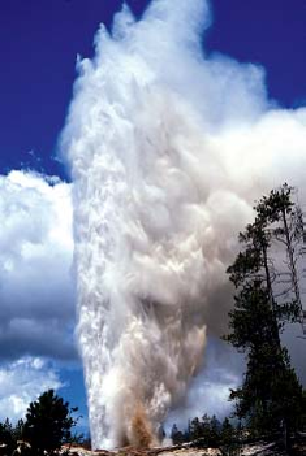Travel Reference
In-Depth Information
the world's largest geyser. It has had an extremely erratic record of major eruptions, the first
one noted in 1878. Since then its interval has ranged from a few days to 50 years! Eruptions
were rare until the 1960s, when there were over one hundred of them. Three occurred in the
1970s and at least 40 in the 1980s. When Steamboat seems to be heating up, geyser watchers
hope for more frequent eruptions, but they have been disappointed in recent years. Two erup-
tions occurred in 2002, three in 2003, and one in 2005.
A thrilling Steamboat Geyser eruption, May 23, 2005
Steamboat's major eruptions come with a tremendous roar and sometimes reach 380 feet
(116 m), an almost unbelievable height three times that of Old Faithful. The water phase of
these eruptions may last 3 to 20 minutes, followed by as much as 12 hours of the steam phase.
Minor eruptions from its two vents may go to 40 or 60 feet (12-18 m).
Bearing left after Steamboat's lower overlook you find
Echinus Geyser,
still an interesting
geyser, but now infrequent and erratic. Ferdinand Hayden named it Echinus (“spine” in
Greek) in 1878 for surrounding sinter-coated rhyolite rocks that resembled tiny spiny sea
urchins (not so evident now). Its water is very acidic, unlike the alkaline water of Yellowstone's
other large geysers.
Echinus became an interesting geyser in the 1970s; into 1998 its eruptions were both large
and predictable, but since that time eruption patterns have become variable. The geyser has

